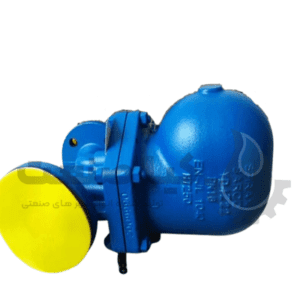Thermostatic steam trap
Showing the single result
Thermostatic steam trap
Thermostatic steam trap is a type of steam trap that works based on temperature difference. It is designed to drain condensate from the steam system while preventing steam from escaping.
[read more]
A thermostatic trap uses a combination of a thermostatic element and a valve to control the flow of condensate and steam.
A thermostatic element is a temperature-sensitive device that expands and contracts based on the temperature of the condensate.
When the condensate reaches a certain temperature, the thermostatic element expands and opens the valve, allowing the condensate to drain.
When the condensate is drained, the thermostatic element contracts and closes the valve, preventing steam from escaping. This helps to save energy and increase the efficiency of the steam system.
Thermostatic steam traps are commonly used in industrial and commercial applications where there is a need to effectively remove condensate from the steam system. They are available in different sizes and designs to suit different steam system needs.
A thermostatic steam trap is a steam trap that works by using the concept of temperature difference between steam and cold condensate and air.
In this type of trap, steam increases the pressure in a thermostatic element.
This causes the thermostatic steam trap to close.
As non-condensable gases and condensate return to the top of the cooler, the temperature begins to drop and the thermostatic element contacts to open a valve.
The amount of backup condensate before the thermostatic steam trap depends on steam pressure, load conditions and pipe size.
A thermostatic steam trap is also used to pass air through a steam system.
As the air collects, the temperature drops and the air vent automatically vents air at a lower average temperature than the thermostatic vapor traps can be available in either the wafer element or balanced pressure.
These vapor traps are produced using different materials such as carbon steel, stainless steel and bronze. Thermostatic steam traps are used to handle light condensate loads.
How does a thermostatic steam trap work?
A thermostatic steam trap can operate using balanced pressure.
In this case, the trap starts by forcing air and condensate before the steam through the steam trap.
This thermostatic element is fully forward while the valve is held open to the point where steam approaches the trap.
When the temperature in the thermostatic steam trap rises, it immediately heats the charging element and then increases the internal steam pressure.
As the pressure in the element equalizes to the system pressure of the steam trap body, the element expands and closes the valve.
When the internal temperature of the trap drops to a few degrees below the temperature of the saturated steam, the element is placed by the unbalanced pressure which opens the valve.
Method of using wafer in thermostatic steam trap
Another method of using a thermostatic vapor trap is balanced pressure wafer operation. This method is similar to balanced bellows.
The wafer is partially filled with a liquid. When the temperature in the vapor trap increases, it heats the charged wafer, thereby increasing the internal vapor pressure.
As the pressure in the wafer exceeds the pressure of the surrounding vapor, the wafer membrane is pressed against the seat of the closing valve.
The droplet temperature from the condensate or non-condensable gas cools and reduces the pressure inside the wafer, which allows the wafer to show seating.
The liquid expansion thermostatic steam trap has a constant temperature discharge feature, this trap can be used as a silent discharge thermostatic trap.
In this case, the output always points upwards, as shown in the figure below.
which helps to increase the continuous immersion of the element with oil.
Since this trap can be discharged at temperatures between 60 and 100°C, it can only open normally during start-up.
A liquid expansion thermostatic steam trap can be installed alongside the main steam trap, which is normally connected to a plumbing condensate return line.
Advantages of thermostatic steam traps
Energy efficient: Thermostatic steam trap provides precise temperature control and allows steam to condense efficiently, preventing steam waste. This helps reduce energy consumption and operating costs.
Durability: Thermostatic steam traps are usually strong and durable and are used for high pressure and high temperature environments. They can withstand harsh operating conditions and ensure longer life and lower maintenance requirements.
Fast Response Time: These traps can respond quickly to temperature changes, allowing for effective condensate removal and preventing vapor lock. This ensures effective heat transfer and maintains optimal system performance.
Adaptability: Thermostatic traps are designed to withstand variable loads and can accommodate a wide range of operating conditions. They can operate in low load situations and are suitable for various steam applications.
Disadvantages of steam trapTRhemostatic
Limited Turn Ratio: Thermostatic steam traps may not perform optimally in low load conditions. They can have a limited turn ratio, which means they may not effectively remove condensate when steam flow is reduced significantly.
حساسیت به کثیفی و آلاینده ها:
Thermostatic traps are more prone to blockage and malfunction due to the accumulation of dirt, debris and sediment. This can negatively affect their performance and require regular maintenance and cleaning.
Higher initial cost:
Thermostatic steam traps are more expensive compared to other types of steam traps. Their complex design and performance contribute to higher production and purchase costs.
maintenance requirements:
Thermostatic traps may require periodic inspection and maintenance to ensure proper operation. This can involve disassembling and cleaning the trap, which can lead to system failure and additional labor costs.
High steam power required: Thermostatic steam traps require high steam power for their optimal performance. This can increase initial and operating costs.
Sensitivity to pressure fluctuations:
Thermostatic steam traps may be sensitive to pressure fluctuations and perform poorly due to these fluctuations. Therefore, they need accurate control of steam pressure and management of steam lines.
Need for bigger space:
Compared to other steam traps, thermostatic steam traps require a larger space to move and install properly. This may create space limitations in some cases.
Limited adjustability:
Thermostatic steam traps are often set for a specific temperature and it is not possible to change the temperature independently. This can create application limitations in some cases.
Types of thermostatic steam traps
1-Balanced pressure thermostatic steam trap
2- bimetallic thermostatic steam trap
Balanced pressure thermostatic steam trap
Balanced pressure thermostatic steam trap is an improved liquid expansion thermostatic steam trap.
The working temperature of this trap is influenced by the steam pressure around it.
This trap works by using an element that is a capsule with a mixture of water and a special liquid with a lower boiling point than water.
At launch, there are cold conditions and the capsule is quiet. The valve of this trap is completely open and out of its seat.
This allows for unlimited air removal.
This is a characteristic of a balanced pressure steam trap and therefore these traps are suitable for air venting.
As the condensate flows through this trap, heat is transferred to the liquid in the capsule.
The liquid then evaporates before the vapor reaches the trap
. The steam pressure of the capsule causes it to expand and then closes the valve.
If the temperature lost from the balanced thermostatic steam trap cools the water around the capsule while the steam causes the capsule to condense, this causes the valve to open and release the condensate until the steam starts again and the cycle continues. start over
Currently, pressure balanced thermostatic steam trap manufacturers design these traps using stainless steel.
Initially, manufacturers of thermostatic steam traps used non-ferrous materials, which were later found to be susceptible to water hammer damage.
The use of stainless steel makes this thermostatic steam trap more reliable and resistant to corrosion and water hammer.
bimetallic thermostatic steam trap
It is a type of thermostatic steam trap that is made using two strips of different metals that are welded together to form a single element.
The simple element used in this type of steam trap considers two main factors, which are:
The operation of this bimetallic thermostatic steam trap occurs at a specific temperature that does not meet the needs of a steam system that operates at different temperatures and pressures.
A bimetallic strip exerts only a small force. Likewise, a large mass must be used to slow down its response to temperature changes in the steam.
Steam trap performance can be determined by checking its response in the steam saturation curve.
A good answer is one that closely follows the curve and just below it.
A basic bimetallic element reacts linearly to temperature changes.
Some bimetallic thermostatic steam traps use two different bimetallic leaves in a stack that operate at different temperatures.
A bimetallic thermostatic steam trap makes better use of a disc spring thermostatic element.
This element consists of bimetal discs.
If the discs act directly between the valve seat and the valve stem, they cause the condensate discharge temperature to change linearly with the change in pressure.
Applications of thermostatic steam trap
1- Bimetallic thermostatic steam traps are used in cooking kettles.
2- It is used in steam tracing lines.
3- These traps are used in disinfectants.
4- Bimetallic thermostatic steam traps are used in connectors, radiators and unit heaters.
5- Thermostatic traps are used in heating coils.
6- They are used in evaporators.
Overall, the thermostatic trap has significant advantages due to its precise temperature control, durability, and good versatility. However, some disadvantages, such as limited rotation ratio and sensitivity to dirt and the need for high steam power, may lag behind their optimal performance in some cases. Therefore, before using them in certain industries and systems, it is necessary to consider the advantages. Check the pros and cons carefully.
شما می توانید انواع تله بخار مانند تله بخار ترموستاتیک، تله بخار فری فلوت ، تله بخار باگت، تله بخار ترمودینامیک، تله بخار فلوتر ترموستاتیک را از کیاصنعت تهیه کنید.
همچنین شما می توانید مقاله انتخاب تله بخار مناسب را مطالعه کنید.


